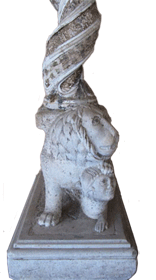THE ROMAN MARBLE MASTERS
The ancient Romans loved Opus Sectile, technique that, using precious marble and glass paste inlay, was used for floors, panels and wall decorations in general.
Initially, the inlays represented patterns, to arrive later, as in the so-called Basilica of Junius Bassus of the fourth century, to the depiction of great scenes.
 |
 |
 |
 |
 |
| Basilica of Junius Bassus - click to enlarge |
With the fall of the Western Roman Empire the taste for the inlays emigrated to Byzantium, but when in Rome, in the tenth - eleventh century, began to flourish again that school of marble workers, which was called the “Maestri Marmorari Romani”(= Roman Marble Masters), the inlays spread in the cloisters, in the tabernacles, furnitures, floors and in the funerary monuments of the Christian churches.
The style was named cosmatesco after the founder of one of the most famous families of the Roman marble masters, Teobaldo of Cosma, that is son of Cosma. This style took pieces of marble, precious stones, glass paste and gold, to create geometric or, more generally, abstract motifs.
 The descendants of Teobaldo are the Cosmati in the strict sense, they were Lorenzo son of Teobaldo, Giacomo son of Lorenzo, Cosma son of Giacomo, Luca and Giacomo Junior children of Cosma. The descendants of Teobaldo are the Cosmati in the strict sense, they were Lorenzo son of Teobaldo, Giacomo son of Lorenzo, Cosma son of Giacomo, Luca and Giacomo Junior children of Cosma.
This dynasty covers a period of about a century, from 1160 to 1260.
But Cosma was a rather common name, so to confuse us, to the family of Teobaldo paralleled that of Cosma son of Pietro Mellini, with his son Deodato, his nephew Giovanni and in addition fifty various relatives. This family was active in Rome approximately from 1260 to the end of 300.
To the Roman Marble Masters rightfully belongs the Vassalletto family. Their founder was Basiletto, followed by his son Pietro, his grandson Vassalletto II and great-grandson Nicola.
The Vassalletto were active from 1160 to the end of 1200.
Lastly, the same Arnolfo di Cambio, when he came to Rome, was conquered by the cosmatesco style.
Art historians are divided between those who believe that one can speak of cosmatesco style only referring to the family of Teobaldo di Cosma, for others, considered the common technique adopted, under the same hat are the Cosma of Teobaldo, those of Cosma son of Pietro Mellini and Vassalletto.
According to both schools of thought is not permissible to speak of cosmatesco style, outside of these families, although in southern Italy we find decorative motifs, generically called cosmateschi, where local influences are also evident, in particular, of Arabic origin, which then with Cosmati have little to do.
Returning to Rome to not upset anyone we will use the expression “Roman Marble Masters”.
Among them, however, you can pick obvious differences.
To the Vassalletto family, in particular to Pietro and to his son Vassalletto II, are attributed the extraordinary cloisters of St. John Lateran and St. Paolo fuori le Mura,
miraculously survived the disastrous fire of 1823.
The Vassaletto are characterized because they employ the cosmatesco style within complex architectural designs, while the two Cosma families, mainly dedicated to the creation of funerary monuments, furnitures and floors. As we can see in: Santa Maria in Aracoeli, Santa Maria sopra Minerva, Oratory of San Silvestro, at the Four Crowned Saints, Santa Maria in Cosmedin, Santa Maria Maggiore, and San Cesareo, to mention only some of their works.
The Roman Masters cover a span of time from the beginning of the eleventh century to the end of the fourteenth, although other Masters in later boasted dubious descent from the originals.
The great Arnolfo di Cambio, when he came to Rome in the late 1270s, emloyed the cosmatesco style, as can be seen in the ciborium of Saint Cecilia, in that of St. Paul Outside the Walls and in the tomb of Cardinal Riccardo Annibaldi, reassembled in the cloister of St. John Lateran.
 |
 |
 |
 |
 |
| The Ciborium of St. Paul Outside the Walls - click to enlarge |
As sculptor Arnolfo, in Rome, has left us a portrait of
Charles I of Anjou, exhibited in the Capitoline Museums, in the Vatican Basilica the statue of St. Peter, in the “caves” of the Vatican the tomb of Boniface VIII and the Nativity Scene in Santa Maria Maggiore, in which Madonna was remodeled in the seventeenth century.
Arnolfo was also an architect, for the stylistic characteristics is attributed to him, without evidence, the general architecture of Santa Maria in Aracoeli, documents in this regard have not been found, but it seems plausible.
back |

